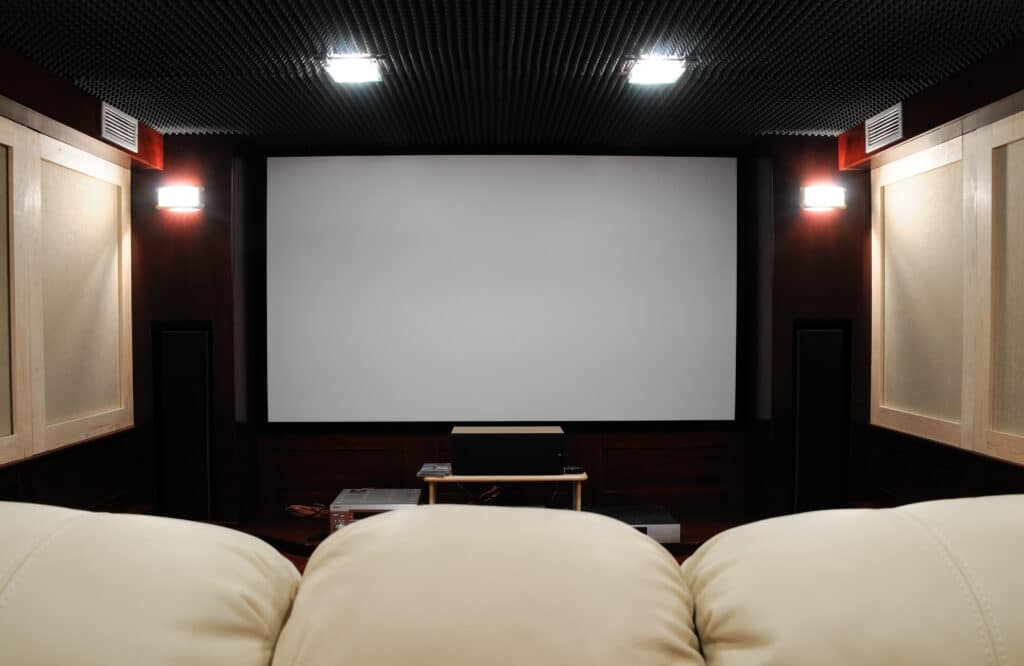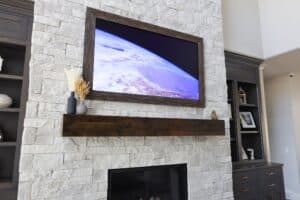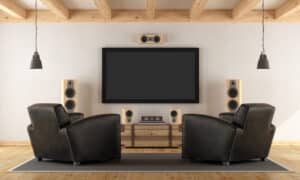When deciding on a projector vs TV for home theater, there are many factors to consider. For example, if you’re looking for something more affordable that can still provide an immersive experience with the biggest display, a projector might be the right choice. On the other hand, if you want to access all the latest technology and features to enjoy top-of-the-line audio and video quality with crystal clear clarity, then a high-end 4K Ultra HDR TV might be better.
For your home theater components, the decision will come down to your specific needs and preferences. However, we’ve put together projector vs tv background information and a list of the pros and cons of both options to help make your home theater decision a little bit easier.
Home Theater Screen Resolutions
To start understanding home theater viewing options, where terms like 4K and UHD are used regularly, it’s important to understand a bit about screen resolution. The better the resolution of your TV, the better quality of the picture you will see. Screen resolution is the width of the frame (1920px) multiplied by the height of the frame (1080px). The more pixels there are, the better your picture will be.

Home Theater Projector Basics
When it comes to building a home theater, choosing the right projector is key to creating a true cinematic experience. Projectors come in various types and technologies, each offering unique benefits and features. Let’s explore the main types of projectors, key terms, and what to look for in a projector screen to help you make the best choice for your space.
Projector terms:
Home theater projectors are available in a range of technologies, including:
Lamp-Based Projectors: These are traditional projectors that use replaceable lamps to create images. They are usually more affordable but require periodic lamp replacement.
Laser Projectors: Using lasers instead of lamps, these projectors offer higher brightness, better color accuracy, and a longer lifespan. They tend to be more expensive but are a worthwhile investment for those seeking top-notch image quality.
Triple Laser Projectors: With three lasers (typically red, green, and blue), these projectors produce even richer colors and enhanced brightness. They are among the highest quality projectors available, ideal for high-end home theaters.
3LCD Projectors: These projectors use three LCD panels (red, green, and blue) to produce vibrant colors and clear images. They’re known for good color reproduction, making them suitable for rooms where color accuracy is a priority.
DLP Projectors: Digital Light Processing (DLP) projectors use a chip with tiny mirrors to project images. They offer high contrast and sharp images, popular for those who prioritize crisp visuals.
D-ILA Projectors: D-ILA (Digital Direct Drive Image Light Amplifier) technology, developed by JVC, uses reflective liquid crystal chips to produce excellent black levels and superior contrast, making it perfect for dark room setups.
While there is no standard size for a projector screen, the most popular sizes for home theater are 100-120 inches. However, Samsung’s ultra short throw projector, The Premiere, goes up to 130 inches.
Projector Types by Placement
Projector placement is a crucial consideration, especially if you have limited space. Here are the main placement-based projector types:
- Short Throw Projectors: Designed for small spaces, short throw projectors can be positioned close to the screen, typically within 3-8 feet. They reduce shadows and are ideal for rooms where space is limited.
- Ultra-Short Throw Projectors: With a throw ratio of less than 0.4, these projectors are designed to sit just beneath or next to the screen, requiring very little space. They offer a large image from a close distance, perfect for compact rooms. Samsung’s “The Premiere” ultra-short throw projector can project up to a 130-inch screen.
Home Theater TV Basics
Home theater television choices include a lot of jargon. To help you keep it straight, here are some of the more common terms.
TV terms:
Smart TV — Smart TVs are televisions that have integrated internet connectivity. This allows them to access streaming content, as well as apps and other features. Smart TVs often come with built-in voice assistants, such as Amazon’s Alexa or Google Assistant. However, not all TVs come with this feature.
LED — An LED TV is a type of LCD TV. It uses light-emitting diodes (LEDs) to create the image on the screen. This type of TV is often thinner and more energy-efficient than other types.
QLED — A QLED TV is a type of LED TV. It uses quantum dots to create the image on the screen, which means it can produce more colors than other LED TVs.
OLED — An OLED TV is a type of LED TV. It uses organic light-emitting diodes to create the image on the screen. This type of TV is often thinner and more energy-efficient than other types.
NeoQLED — A NeoQLED TV is a type of QLED TV. It uses quantum dots to create the image on the screen, which means it can produce more colors than other QLED TVs.
New tv options range in size up to 85+ inches. For example, Sony’s 100” BRAVIA XR X92 4K HDR Full Array LED with Smart Google TV, released in 2021.
Projector vs TV for Home Theater
When comparing a projector vs TV for your home cinema you want to consider a few different factors.
Size
For a home theater, display size matters. Depending on the size of your space, you’ll want to ensure that you purchase a display that is large enough for your needs.
TV: A top-of-the-line 4K Ultra HD TV can provide excellent picture quality, but these enormous displays can be costly. Furthermore, HDTVs have a set screen size with an average screen width of 13 to 80 inches diagonally. Thus, once you choose a screen size, you are committed.
Projector: Typically, a projector’s display is larger than a television due to the flexibility in screen size that a projector provides, with screens 100+ inches. If you have limited space, a projector may not be ideal. However, if you want an immersive experience with a huge screen, that’s what you’ll get with a projector.
The ultimate home theater display choice comes down to size. First, the size of your display wall constrains the size of the display screen you can use. Second, how big is the room and how far back will the seating be? There is an optimal viewing angle that must be preserved.
Get Ready to Measure
Grab your tape measure and measure the distance from the screen to your main sitting position to get the most out of your experience. Most people consider a 30-degree field of vision adequate for a 16:9 ratio screen when they sit in the middle row in a commercial theater. A 42-degree field of vision is usually preferred for a 2.40 widescreen. If you like to sit closer to the front row, a 36-degree field of vision is best for 16:09 and a 48-degree field of vision will be great for a screen with a ratio of 2.40.
So, how can you determine your ideal screen size using this information?
Middle Row Viewing
Take the distance you’ll be from the screen in inches and multiply it by.6149 to get the screen diagonal for a 16:9 screen with a 30-degree field of vision. For a 2.40 widescreen display, use .83 as your multiplier.
Front Row Viewing
For a 16:9 screen with a 36-degree field of vision, use your distance from the screen, convert it to inches, and multiply it by. 746 to get the suggested diagonal size. To obtain a 48-degree viewing angle when using a 2.40 display, you must first calculate your distance times .963.
Contrast & Color Accuracy
The contrast of your screen is another key factor to consider. Contrast helps determine how well the projector screen or television displays blacks and whites, which can significantly impact your viewing experience. Equally important is the color accuracy, which is how well the projector or tv renders colors.
TV: With a high-end 4K TV, you can get excellent contrast and color accuracy. This is due to the enhanced refresh rate and pixel density of 4K TVs.
Projector: The contrast ratio of a projector is not as good as that of a television. However, this difference is gradually closing due to new technological advancements. Projector brightness, on the other hand, might differ from one projector to the next; therefore, be sure you do your homework before selecting the ideal projector for your home theater space.
Resolution
In the projector vs TV debate, the resolution of each option is also important. Resolution refers to how many pixels are available on your projector or television display to create sharp and detailed images. This is especially important when watching 4K content like movies and sports, but this can also make a difference when watching television or playing video games.
TV: 4K Ultra HD TVs provide the highest resolution, which is four times better than full high definition (HD). This technology offers more pixels for sharper and crisper image quality displayed in stunning color.
Projector: A projector can provide excellent resolution depending on its projector technology. For instance, 4K projector models are available today, which can provide you with more pixels than HDTVs for a truly immersive experience.
Brightness
Another one of the biggest differences between a TV and projector is brightness. Brightness refers to how much light your projector or television emits, measured in lumens. This is a key factor to consider when purchasing a projector or TV for a home theater because you want to ensure that your projector or television can provide enough light for the environment.
TV: 4K Ultra HD TVs have high brightness levels. The enhanced refresh rate and pixel density contribute toward providing images with stunning color, while the HDR technology offers increased brightness to give you a more detailed picture.
Projector: The projector’s light output is usually around 1000 lumens or less for front projectors and 2000+ lumens for short-throw projectors. Thus, projector models can be quite bright when the projector technology is new on the market; projector brightness may decline over time.
Installation
Installing your TV or projector setup isn’t necessarily complicated, but there are differences between the two processes.
TV: Installing a television is typically a simple process that most people can do. All you need is the TV, a power outlet, and a wall-mount or stand to place your TV on.
Projector: Installing a projector can be more complex than installing a television. Projector installation usually requires a projector mount, which can be tricky to install if you’re not familiar with it. You’ll also need an appropriate place to set up your projector and ensure that the space is dark enough for the projector to work correctly.
Room Setup
When deciding between a TV or projector, consider your room setup. Depending on the size, space, and configuration of the room you’re setting up, one device may be better than another.
TV: A TV is best set up in a living space with enough room to accommodate its size and shape. This can be done by hanging it on a wall mount or placing it on an entertainment stand. If you decide to hang your TV on the wall, make sure you have a sturdy mount that can support the weight of your TV.
Projector: A projector usually requires more setup than a television. Projector installation may require you to purchase an appropriate projector mount, which can be expensive depending on the projector’s quality and weight. You’ll also need to find a place in your home where you can set up the projector and ensure enough space for it. Additionally, projector placement is critical because you want to ensure that the projector isn’t too close or too far from your screen.
Convenience
When you’re thinking about TV and projector options, consider the convenience. A projector can provide an excellent experience on its own. Still, it requires more setup than a television, and there’s also no guarantee that your projector setup will work well or look good depending on how bright your projector model is, where you place the projector, and how big your screen is.
TV: A television is a more convenient option because it doesn’t require installation or much setup. You can simply plug it into an outlet and start watching TV. Additionally, TVs come in many different sizes, so you’re likely to find one that fits well in your home.
Projector: A projector is only convenient if you already have a projector mount, and the projector setup works well. If your projector’s brightness isn’t particularly high or it doesn’t work with your screen size, then setting up the projector may not be worth the hassle of installation.
Technology
TVs and projectors use sources and cables to bring images and videos to your screen. The source can be anything from a DVD player to a cable box to a streaming device. The cables then carry the signal from the source to the projector or TV. There are different types of cables available, and each one provides a different level of quality for your viewing experience.
TV: Standard HDMI cables are the most common cable used with TVs. These cables provide quality audio and video and are available in different lengths.
Projector: Projector users typically have more options when it comes to cables. Projector users can use HDMI cables, DisplayPort cables, or VGA cables to connect their projector to a source. These cables provide different levels of quality, with HDMI being the best and VGA being the worst. Additionally, projector users can use wireless connections to connect their projector to a source.
What’s the Best Home Theater Display for You?
When it comes to choosing the best display components for your home theater, it ultimately depends on your needs and priorities.
TVs for Home Theater
If you’re looking for a more convenient option with less setup required, then a television is the best choice for you. However, there are various types of TVs on the market, so it’s essential to do your research before purchasing.
Here are a few of the most popular tv choices for home theaters:
4K tv
If you plan on watching 4K content in the future, then a 4k TV is your best option because it can display 4k video and other high-resolution. They’re also known as Ultra-HD or UHD TVs since they have a higher resolution and greater image quality. With a resolution of 3840 horizontally and 2160 vertically, 4k TVs have 8.3 million pixels overall. Higher pixel count means better resolution and clarity in picture display than a standard HD or 1080p TV.
LCD tv
LCD TVs are one of the most common types of tv screen technology. This type of projector is made up of millions or even billions (think TVs, tablets, smartphones) of liquid crystals that can either block light (transmitting dark images) or let the light shine through to form pure white. These TVs have a wide viewing angle, and the colors are fairly accurate. LCD TVs can also produce a sharper image quality, but they’re not as bright or high contrast as LED tv sets.
OLED tv
OLED is another type of display technology becoming more popular. Delivering the deepest blacks and brightest whites along with an infinite contrast range, many consumers believe this type of TV offers the best picture quality. Because the compound is light-emitting, OLEDs can display deeper blacks than LCDs and generally show better contrast ratios in natural light because no backlighting is required. They may also be thinner than LCDs. However, they can be expensive and are not as common as LED or LCD TVs.
QLED tv
Quantum light-emitting diode (QLED) displays are the future of LCDs. The use of tiny nanoparticles called quantum dots to color and brighten contemporary LCD screens improves their appearance. QLED TVs may be larger, last longer, and are more resistant to burn-in. They’re also cheaper than OLED displays and can be much brighter. However, they may not offer the same dark-black levels as OLED TVs.
Read More: LED vs OLED vs QLED: What’s the Difference?
Projectors for Home Theater
However, if you’re willing to put in a bit more effort and are interested in getting the best possible product, a home theater projector is a better option. Taking the time to find the right projector and set it up correctly will reward you with an excellent experience that’s sure to impress guests.
DLP Projector
The modern-day projector will use DLP (Digital Light Processing) technology, which requires a digital ‘mirror’ to create an image by reflecting them onto a chip positioned behind a projector lens. The chip is coated with micromirrors to bounce the beam back and forth horizontally several hundred times before it projects out as a color pixel on a wall or other viewing surface.
4K Projector
There are also a growing number of projector options on the market. This type of projector will give you a resolution that is four times that of 1080p, resulting in an even more impressive cinema experience.
Not sure about the best home theater display for your home cinema? We can help.
Overall, it’s important to do your research and find the right one for you, whichever device you choose. By considering all these factors, you can make an informed decision that will provide you with years of home entertainment.
Need help choosing between a tv and a projector for your Northern Utah home theater? Contact your home theater experts at AIS today!
For more information on Home Theater Automation, check out our Home Theater Automation 101: Upgrade Your Life guide.




